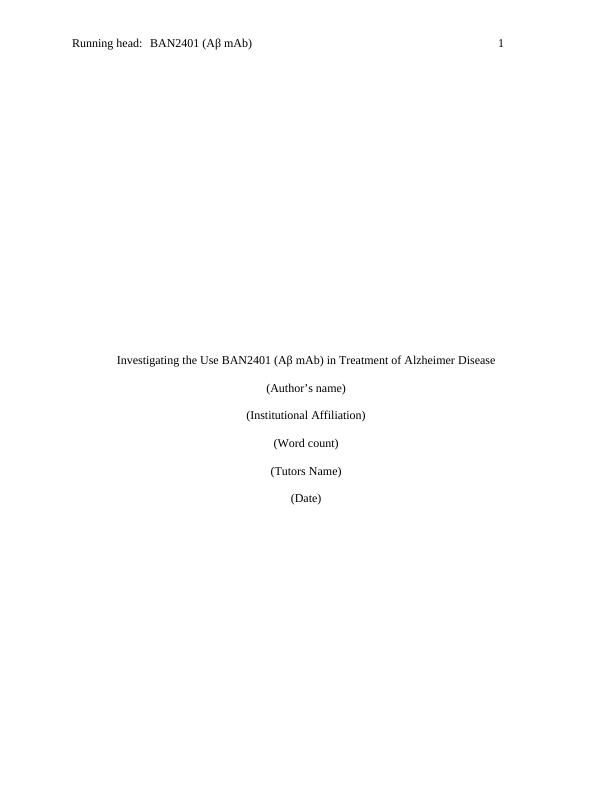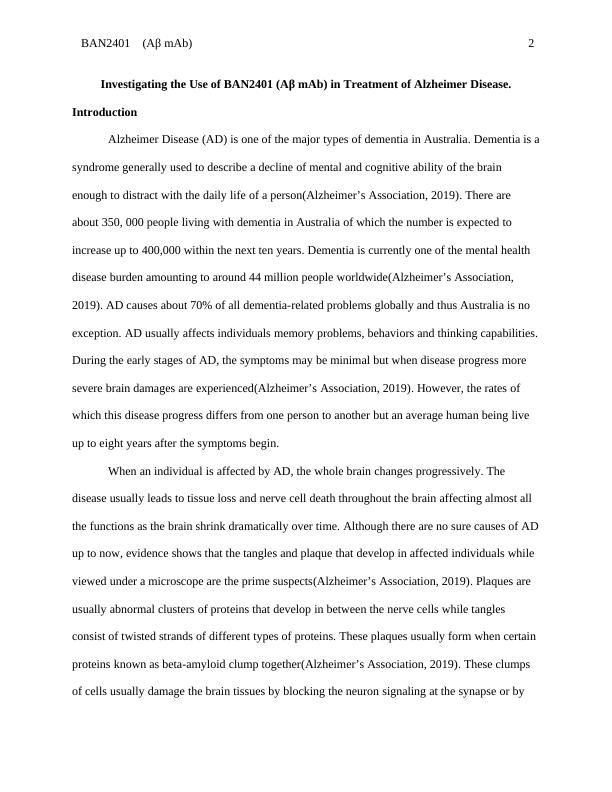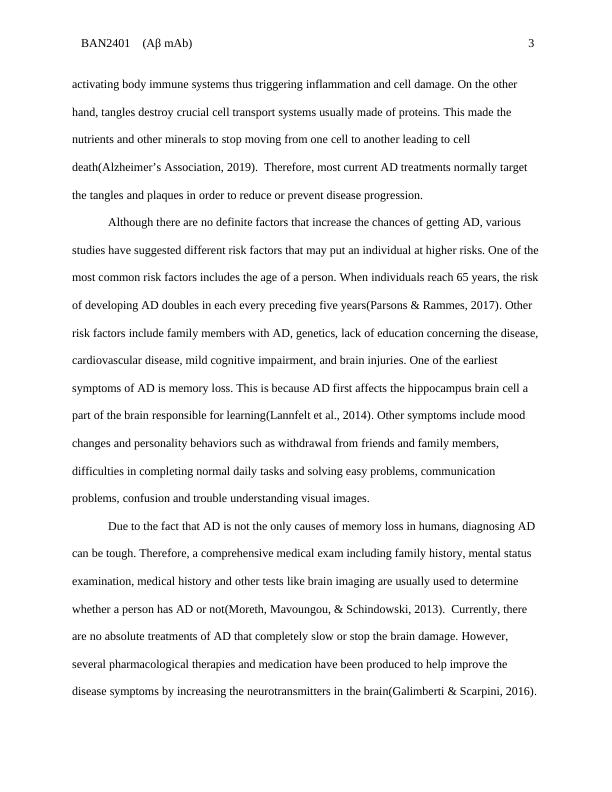Investigating the Use of BAN2401 (A? mAb) in Treatment of Alzheimer Disease
Added on 2022-11-22
10 Pages3149 Words197 Views
Running head: BAN2401 (Aβ mAb) 1
Investigating the Use BAN2401 (Aβ mAb) in Treatment of Alzheimer Disease
(Author’s name)
(Institutional Affiliation)
(Word count)
(Tutors Name)
(Date)
Investigating the Use BAN2401 (Aβ mAb) in Treatment of Alzheimer Disease
(Author’s name)
(Institutional Affiliation)
(Word count)
(Tutors Name)
(Date)

BAN2401 (Aβ mAb) 2
Investigating the Use of BAN2401 (Aβ mAb) in Treatment of Alzheimer Disease.
Introduction
Alzheimer Disease (AD) is one of the major types of dementia in Australia. Dementia is a
syndrome generally used to describe a decline of mental and cognitive ability of the brain
enough to distract with the daily life of a person(Alzheimer’s Association, 2019). There are
about 350, 000 people living with dementia in Australia of which the number is expected to
increase up to 400,000 within the next ten years. Dementia is currently one of the mental health
disease burden amounting to around 44 million people worldwide(Alzheimer’s Association,
2019). AD causes about 70% of all dementia-related problems globally and thus Australia is no
exception. AD usually affects individuals memory problems, behaviors and thinking capabilities.
During the early stages of AD, the symptoms may be minimal but when disease progress more
severe brain damages are experienced(Alzheimer’s Association, 2019). However, the rates of
which this disease progress differs from one person to another but an average human being live
up to eight years after the symptoms begin.
When an individual is affected by AD, the whole brain changes progressively. The
disease usually leads to tissue loss and nerve cell death throughout the brain affecting almost all
the functions as the brain shrink dramatically over time. Although there are no sure causes of AD
up to now, evidence shows that the tangles and plaque that develop in affected individuals while
viewed under a microscope are the prime suspects(Alzheimer’s Association, 2019). Plaques are
usually abnormal clusters of proteins that develop in between the nerve cells while tangles
consist of twisted strands of different types of proteins. These plaques usually form when certain
proteins known as beta-amyloid clump together(Alzheimer’s Association, 2019). These clumps
of cells usually damage the brain tissues by blocking the neuron signaling at the synapse or by
Investigating the Use of BAN2401 (Aβ mAb) in Treatment of Alzheimer Disease.
Introduction
Alzheimer Disease (AD) is one of the major types of dementia in Australia. Dementia is a
syndrome generally used to describe a decline of mental and cognitive ability of the brain
enough to distract with the daily life of a person(Alzheimer’s Association, 2019). There are
about 350, 000 people living with dementia in Australia of which the number is expected to
increase up to 400,000 within the next ten years. Dementia is currently one of the mental health
disease burden amounting to around 44 million people worldwide(Alzheimer’s Association,
2019). AD causes about 70% of all dementia-related problems globally and thus Australia is no
exception. AD usually affects individuals memory problems, behaviors and thinking capabilities.
During the early stages of AD, the symptoms may be minimal but when disease progress more
severe brain damages are experienced(Alzheimer’s Association, 2019). However, the rates of
which this disease progress differs from one person to another but an average human being live
up to eight years after the symptoms begin.
When an individual is affected by AD, the whole brain changes progressively. The
disease usually leads to tissue loss and nerve cell death throughout the brain affecting almost all
the functions as the brain shrink dramatically over time. Although there are no sure causes of AD
up to now, evidence shows that the tangles and plaque that develop in affected individuals while
viewed under a microscope are the prime suspects(Alzheimer’s Association, 2019). Plaques are
usually abnormal clusters of proteins that develop in between the nerve cells while tangles
consist of twisted strands of different types of proteins. These plaques usually form when certain
proteins known as beta-amyloid clump together(Alzheimer’s Association, 2019). These clumps
of cells usually damage the brain tissues by blocking the neuron signaling at the synapse or by

BAN2401 (Aβ mAb) 3
activating body immune systems thus triggering inflammation and cell damage. On the other
hand, tangles destroy crucial cell transport systems usually made of proteins. This made the
nutrients and other minerals to stop moving from one cell to another leading to cell
death(Alzheimer’s Association, 2019). Therefore, most current AD treatments normally target
the tangles and plaques in order to reduce or prevent disease progression.
Although there are no definite factors that increase the chances of getting AD, various
studies have suggested different risk factors that may put an individual at higher risks. One of the
most common risk factors includes the age of a person. When individuals reach 65 years, the risk
of developing AD doubles in each every preceding five years(Parsons & Rammes, 2017). Other
risk factors include family members with AD, genetics, lack of education concerning the disease,
cardiovascular disease, mild cognitive impairment, and brain injuries. One of the earliest
symptoms of AD is memory loss. This is because AD first affects the hippocampus brain cell a
part of the brain responsible for learning(Lannfelt et al., 2014). Other symptoms include mood
changes and personality behaviors such as withdrawal from friends and family members,
difficulties in completing normal daily tasks and solving easy problems, communication
problems, confusion and trouble understanding visual images.
Due to the fact that AD is not the only causes of memory loss in humans, diagnosing AD
can be tough. Therefore, a comprehensive medical exam including family history, mental status
examination, medical history and other tests like brain imaging are usually used to determine
whether a person has AD or not(Moreth, Mavoungou, & Schindowski, 2013). Currently, there
are no absolute treatments of AD that completely slow or stop the brain damage. However,
several pharmacological therapies and medication have been produced to help improve the
disease symptoms by increasing the neurotransmitters in the brain(Galimberti & Scarpini, 2016).
activating body immune systems thus triggering inflammation and cell damage. On the other
hand, tangles destroy crucial cell transport systems usually made of proteins. This made the
nutrients and other minerals to stop moving from one cell to another leading to cell
death(Alzheimer’s Association, 2019). Therefore, most current AD treatments normally target
the tangles and plaques in order to reduce or prevent disease progression.
Although there are no definite factors that increase the chances of getting AD, various
studies have suggested different risk factors that may put an individual at higher risks. One of the
most common risk factors includes the age of a person. When individuals reach 65 years, the risk
of developing AD doubles in each every preceding five years(Parsons & Rammes, 2017). Other
risk factors include family members with AD, genetics, lack of education concerning the disease,
cardiovascular disease, mild cognitive impairment, and brain injuries. One of the earliest
symptoms of AD is memory loss. This is because AD first affects the hippocampus brain cell a
part of the brain responsible for learning(Lannfelt et al., 2014). Other symptoms include mood
changes and personality behaviors such as withdrawal from friends and family members,
difficulties in completing normal daily tasks and solving easy problems, communication
problems, confusion and trouble understanding visual images.
Due to the fact that AD is not the only causes of memory loss in humans, diagnosing AD
can be tough. Therefore, a comprehensive medical exam including family history, mental status
examination, medical history and other tests like brain imaging are usually used to determine
whether a person has AD or not(Moreth, Mavoungou, & Schindowski, 2013). Currently, there
are no absolute treatments of AD that completely slow or stop the brain damage. However,
several pharmacological therapies and medication have been produced to help improve the
disease symptoms by increasing the neurotransmitters in the brain(Galimberti & Scarpini, 2016).

End of preview
Want to access all the pages? Upload your documents or become a member.
Related Documents
Alzheimer’s Disease: Symptoms, Causes, and Treatmentslg...
|7
|2010
|405
Understanding the Process of Dementialg...
|11
|3035
|95
These tangles and plaques in the brainlg...
|4
|792
|23
Alzheimer Disease Project PDFlg...
|14
|3441
|143
Alzheimer’s Disease – A Case Studylg...
|7
|1869
|197
Pathophysiology associated with disorder symptoms: An Alzheimer's patientlg...
|7
|1650
|281
